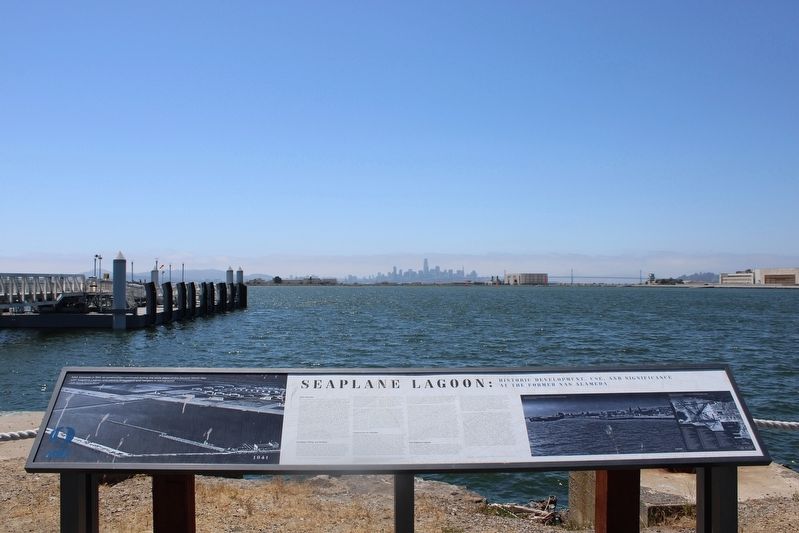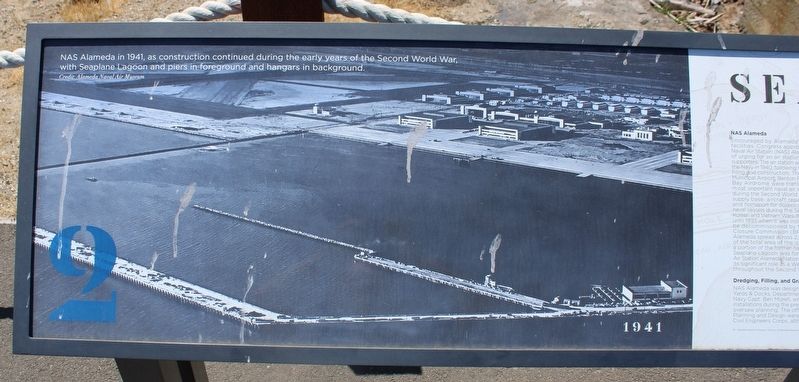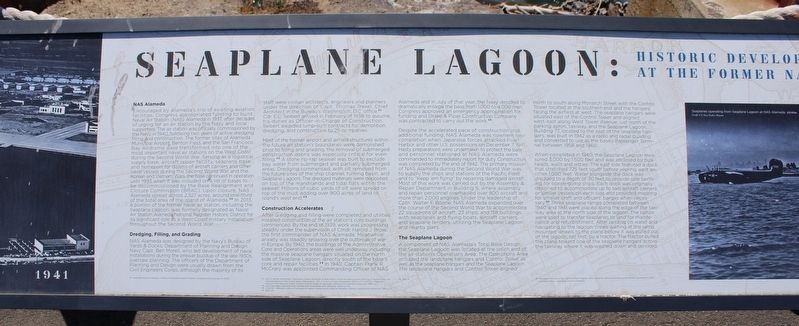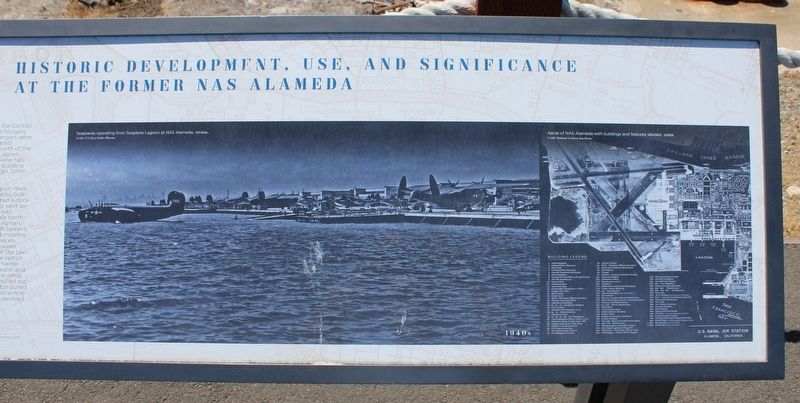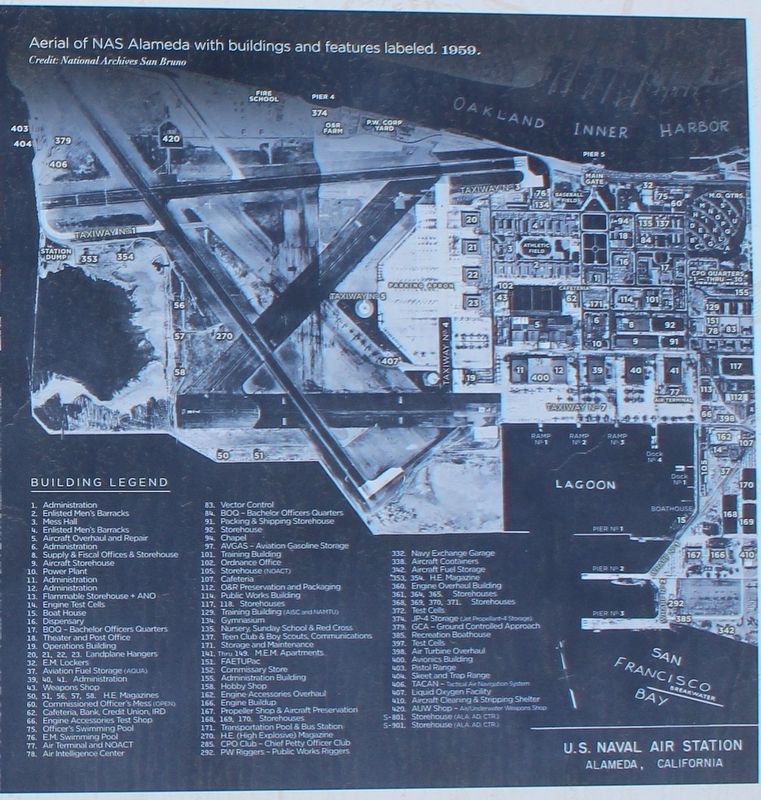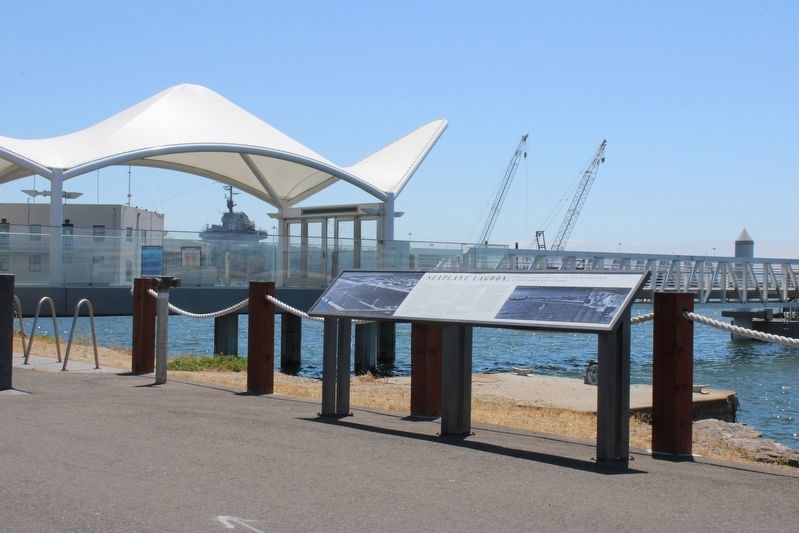Former NAS Alameda in Alameda County, California — The American West (Pacific Coastal)
Seaplane Lagoon
Historic Development, Use, and Significance at the former NAS Alameda
Encouraged by Alameda's trio of existing aviation facilities, Congress appropriated funding to build Naval Air Station (NAS) Alameda in 1937, after decades of urging for an air station by the Navy and local supporters. The air station was officially commissioned by the Navy in 1940, following two years of active dredging, filling and construction. The former sites of Alameda Municipal Airport, Benton Field, and the San Francisco Bay Airdrome were transformed into one of the most important naval air stations on the West Coast during the Second World War. Serving as a logistical supply base, aircraft repair facility, seaplane base and homeport for dozens of aircraft carriers and other naval vessels during the Second World War and the Korean and Vietnam Wars, the base continued in operation until 1993 when it was included on a list of bases to be decommissioned by the Base Realignment and Closure Commission (BRAC). Upon closure, NAS Alameda spread across 2,527 acres, around one-third of the total area of the island of Alameda.10 In 2013, a portion of the former naval air station, including the Seaplane Lagoon, was formally designated as Naval Air Station Alameda National Register Historic District for its significant role as a West Coast military installation throughout the Second World War.
Dredging, Filling, and Grading
NAS Alameda was designed by the Navy's Bureau of Yards & Docks, Department of Planning and Design. Navy Capt. Ben Morell, who led development of naval installations during the prewar buildup of the late 1930s, oversaw planning. The officers of the Department of Planning and Design were usually drawn from the Civil Engineers Corps, although the majority of its staff were civilian architects, engineers and planners under the direction of Capt. Thomas Trexel, Chief Architect in the Bureau's Washington, DC. office.11 Cdr. E.C. Seibert arrived in February of 1938 to assume his duties as Officer-in-Charge of Construction. Seibert awarded lump-sum contracts for demolition, dredging, and construction to 25 companies.
Most of the former airport and airfield structures within the future air station's boundaries were demolished prior to filling and grading; the removal of submerged construction debris was especially critical for even filling.12 A stone rip-rap seawall was built to exclude bay water from submerged and partially submerged areas. Dredging commenced, with silt removed from the future sites of the ship channel, turning basin, and Seaplane Lagoon. The dredged materials were deposited on top of the marshlands and tidal flats within the top of the mud, adding over 900 acres of land to seawall. Millions of cubic yards of silt were spread on island's west end.13
Construction Accelerates
After dredging and filling were completed and utilities installed construction of the air station's core buildings commenced. By the end of 1939, work was progressing steadily under the supervision of Cmdr. Harold J. Brow, the first commander of NAS Alameda. Meanwhile, anxiety was steadily growing over the outbreak of war in Europe. By 1940, the buildings of the Administrative Core and Operations areas were well underway, including the massive seaplane hangars situated on the north side of Seaplane Lagoon, directly south of the base's core and repair facilities.14 In 1940, Captain Frank R. McCrary was appointed Commanding Officer of NAS Alameda and in July of that year, the Navy decided to dramatically enlarge the base from 1,000 to 4,000 men. Congress approved an emergency appropriation for funding and Drake & Piper Construction Company was contracted to carry out the work.15
Despite the accelerated pace of construction and additional funding, NAS Alameda was nowhere near completion when Japanese forces attacked Pearl Harbor and other U.S. possessions on December 7, 1941. Hasty preparations were undertaken to protect the base, and personnel stationed at NAS Alameda were commanded to immediately report for duty. Construction was completed by the end of 1942. The primary mission of NAS Alameda during the Second World War was to supply the ships and stations of the Pacific Fleet and to "Keep 'em flying" by repairing damaged aircraft. Most of this work was carried out by the Assembly & Repair Department in Building 5, where assembly and repair personnel overhauled over 800 aircraft and more than 2,000 engines. Under the leadership of Cptn. Walter F. Boone, NAS Alameda expanded over the course of the Second World War to accommodate 22 squadrons of aircraft, 23 ships, and 158 buildings, with seaplanes and flying boats, aircraft carriers and seaplane tenders, utilizing the Seaplane Lagoon and nearby piers.
The Seaplane Lagoon
A component of NAS Alameda's Total Base Design, the Seaplane Lagoon was located at the south end of the air station's Operations Area. The Operations Area included the landplane hangars and Control Tower as well as the seaplane hangars and the Seaplane Lagoon. The landplane hangars and Control Tower aligned north to south along Monarch Street with the Control Tower located at the southern end and the hangars facing the airfield at west. The seaplane hangars were situated east of the Control Tower and aligned west-east along West Tower Avenue, just north of the parking apron, taxiway, and the Seaplane Lagoon. Building 77, located to the east of the seaplane hangars, was built in 1942 as a radio and radar building and converted to use as the base's Passenger Terminal between 1958 and 1960.
When completed in 1940, the Seaplane Lagoon measured 3,000 by 1,500 feet and was enclosed by bulkheads, walls and jetties. The east side featured a dock that stretched 725 feet south before veering west another 1,000 feet. Water alongside the dock was dredged to a depth of 30 feet to provide safe berthing for ocean-going ships. Each dock was originally designed to accommodate up to two aircraft carriers or similar vessels on each side and provided mooring for smaller craft and officers' barges when necessary.16 Three seaplane ramps completed between 1940 and 1941 were placed along the edge of the taxiway area at the north side of the lagoon. The ramps were used to transfer seaplanes to land for maintenance and refurbishment. After landing on water and navigating to the lagoon, crews waiting at the ramp mounted wheels to the plane before it was pulled out of the lagoon, tail first, by a tractor. The tractor pulled the plane toward one of the seaplane hangars across the taxiway where it was washed down and serviced.
10 Alameda Naval Air Museum, "History of Alameda Naval Air Station," accessed online January 15, 2020.
11 John S. Garner, World War II Temporary Military Buildings: A Brief History of the Architecture and Planning of Cantonments and Training Stations in the United States (Washington, DC: U.S. Army Corps of Engineers, 1993), p. 17; LCDR B.L. Allbrandt. History of the Naval Air Station & Naval Aviation Depot at Alameda, California (unpublished manuscript: 1996), p. 3.
12 LSA Associates, Alameda Point General Plan Amendment EIR, (Berkeley: 2002), p. 143.
13 LCDR B.L. Allbrandt, History of the Naval Air Station & Naval Aviation Depot at Alameda, California, (unpublished manuscript: 1996), p. 3.
14 lbid., 5-6.
15 lbid., 8.
16 Alameda - The Island City. (WPA Writers' Program, 1941). Edited for online publication by Kin Robles, December 27, 2007. Available online via Alameda Naval Air Museum. (Marker Number 2.)
Topics. This historical marker is listed in these topic lists: Air & Space • War, World II • Waterways & Vessels. A significant historical year for this entry is 1937.
Location. 37° 46.643′ N, 122° 17.903′ W. Marker is in Alameda, California, in Alameda County. It is in Former NAS Alameda. Marker is on Ferry Point north of West Oriskany Avenue, on the left when traveling north. The resin marker is mounted to metal posts to the right of the entrance to the Alameda Seaplane Lagoon Ferry Terminal. Touch for map. Marker is in this post office area: Alameda CA 94501, United States of America. Touch for directions.
Other nearby markers. At least 8 other markers are within walking distance of this marker. Seaplanes and Flying Boats at NAS Alameda
(a few steps from this marker); Aircraft Carriers and Seaplane Tenders (within shouting distance of this marker); Alameda: Bay Area Aviation Center (within shouting distance of this marker); Douglas SBD Dauntless (approx. 0.2 miles away); Grumman J2F Duck (approx. 0.2 miles away); Vought A-7A Corvair II (approx. 0.2 miles away); Grumman F6F Hellcat (approx. ¼ mile away); The Jimmy Doolittle Pier – Alameda Naval Air Station (approx. 0.4 miles away). Touch for a list and map of all markers in Alameda.
More about this marker. Inset Images:
NAS Alameda in 1941, as construction continued during the early years of the Second World War, with Seaplane Lagoon and piers in foreground and hangers in background. Credit: Alameda Naval Air Museum
Seaplanes operating from Seaplane Lagoon at NAS Alameda, 1940s. Credit: U.S. Navy Seaplane Museum
Aerial of NAS Alameda with buildings and features labeled, 1959. Credit: National Archives San Bruno
Building Legend
1. Administration
2. Enlisted Men's Barracks
3. Mess Hall
4. Enlisted Men's Barracks
5. Aircraft Overhaul and Repair
6. Administration
8. Supply & Fiscal Offices & Storehouse
9. Aircraft Storehouse
10. Power Plant
11. Administration
12. Administration
13. Flammable Storehouse + ANO
14. Engine Test Cells
15. Boat House
16. Dispensary
17. BOQ-Bachelor Officers Quarters
18. Theater and Post Office
19. Operations Building
20, 21, 22, 23. Landplane Hangers
32. E.M. Lockers
37. Aviation Fuel Storage (AQUA)
39, 40, 41. Administration
43. Weapons Shop
50, 51, 56, 57, 58. H.E. Magazines
60. Commissioned Officer's Mess (OPEN)
62. Cafeteria, Bank, Credit Union, IRD
66. Engine Accessories Test Shop
75. Officer's Swimming Pool
76. EM. Swimming Pool
77. Air Terminal and NOACT
78. Air Intelligence Center
83. Vector Control
84. BOQ-Bachelor Officers Quarters
91. Packing & Shipping Storehouse
92. Storehouse
94. Chapel
97. AVGAS-Aviation Gasoline Storage
101. Training Building
102. Ordinance Office
105. Storehouse (NOACT)
107. Cafeteria
112. O&R Preservation and Packaging
114. Public Works Building
117, 118. Storehouses
129. Training Building (AISC and NAMTU)
134. Gymnasium
135. Nursery, Sunday School & Red Cross
137. Teen Club & Boy Scouts, Communications
171. Storage and Maintenance
141. Thru 149. M.E.M. Apartments
151. FAETUPac
152. Commissary Store
155. Administration Building
158. Hobby Shop
162. Engine Accessories Overhaul
166. Engine Buildup
167. Propeller Shop & Aircraft Preservation
168, 169, 170. Storehouses
171. Transportation Pool & Bus Station
270. HE. (High Explosive) Magazine
285. CPO Club - Chief Petty Officer Club
292. PW Riggers-Public Works Riggers
332. Navy Exchange Garage
338. Aircraft Containers
342. Aircraft Fuel Storage
353, 354. HE. Magazine
360. Engine Overhaul Building
361, 364, 365. Storehouses
368, 369, 370, 371. Storehouses
372. Test Cells
374. JP-4 Storage (Jet Propellant-4 Storage)
379. GCA-Ground Controlled Approach
385 Recreation Boathouse
397. Test Cells
398. Air Turbine Overhaul
400. Avionics Building
403. Pistol Range
404. Skeet and Trap Range
406. TACAN-Tactical Air Navigation System
407. Liquid Oxygen Facility
410. Aircraft Cleaning & Stripping Shelter
420. AUW Shop-Air/Underwater Weapons Shop
S-801. Storehouse (ALA AD CTR)
S-901. Storehouse (ALA AD CTR)
Credits. This page was last revised on September 10, 2023. It was originally submitted on September 6, 2023, by Joseph Alvarado of Livermore, California. This page has been viewed 160 times since then and 49 times this year. Photos: 1, 2, 3, 4, 5, 6. submitted on September 6, 2023, by Joseph Alvarado of Livermore, California.
